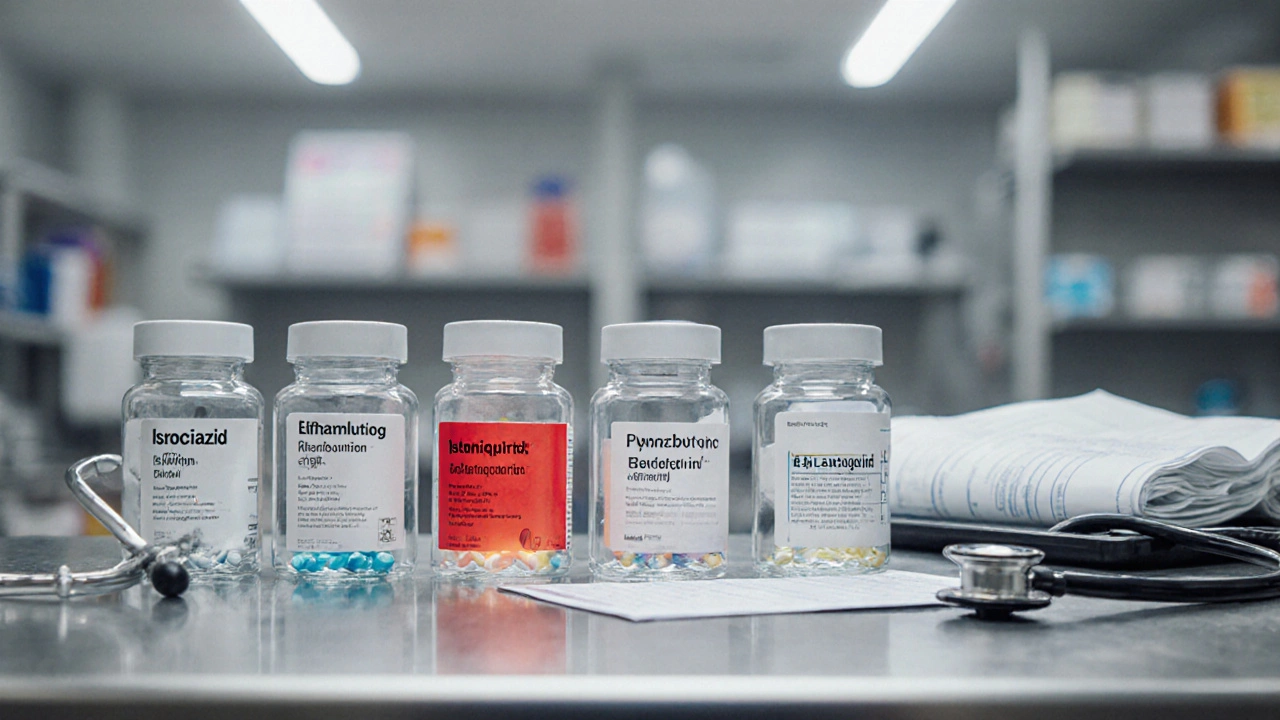Isoniazid vs Rifampin: Key Differences for TB Treatment
When navigating Isoniazid vs Rifampin, a comparative look at two cornerstone tuberculosis drugs. Also known as TB drug comparison, it helps clinicians and patients choose the right regimen. The two drugs target Tuberculosis, the bacterial infection that claims millions of lives each year. Understanding their distinct actions, side‑effect profiles, and resistance patterns is the first step toward effective therapy.
The bacterium behind the disease, Mycobacterium tuberculosis, thrives inside lung tissue and can hide for years. Isoniazid attacks the mycolic acid synthesis pathway, dismantling the cell wall. In contrast, Rifampin binds to the RNA polymerase enzyme, halting protein production. This dual‑mechanism approach is why the World Health Organization recommends both drugs in the standard six‑month regimen.
Why the Comparison Matters
Choosing between the two isn’t a matter of preference; it’s dictated by patient factors and disease stage. Isoniazid vs Rifampin influences the risk of hepatotoxicity, drug‑drug interactions, and the emergence of resistance. For example, patients with pre‑existing liver disease often need close monitoring if they receive isoniazid, while rifampin can reduce the effectiveness of oral contraceptives and certain antiretrovirals. Knowing these nuances lets clinicians tailor therapy and avoid costly treatment failures.
Resistance is another critical piece of the puzzle. When Mycobacterium tuberculosis develops mutations in the katG gene, isoniazid loses potency. Rifampin resistance, on the other hand, usually stems from rpoB gene changes. Because each drug targets a different pathway, using them together reduces the chance that a single mutation will render the regimen ineffective. This synergy is the cornerstone of the Directly Observed Treatment, Short‑course (DOTS) strategy.
Dosing schedules also diverge. Isoniazid is typically given once daily at 5 mg/kg, with a max of 300 mg, while rifampin is administered at 10 mg/kg, up to 600 mg daily. The timing matters: rifampin should be taken on an empty stomach to maximize absorption, whereas isoniazid can be taken with food to lessen stomach upset. These practical details affect patient adherence, a key driver of treatment success.
Side‑effect profiles add another layer of decision‑making. Isoniazid commonly causes peripheral neuropathy, which can be prevented with vitamin B6 supplementation. Rifampin, meanwhile, is notorious for turning bodily fluids orange and causing flu‑like symptoms during the first weeks. Both drugs can lead to liver enzyme elevations, but the pattern and severity differ, making regular blood tests essential for anyone on a prolonged course.
Special populations require extra attention. Children, pregnant women, and people living with HIV each present unique challenges. Isoniazid is considered safe in pregnancy but may require dose adjustment in children due to faster metabolism. Rifampin is also used in pregnant patients but can interact with antiretroviral therapy, demanding careful coordination. Understanding how each drug behaves in these groups helps avoid adverse outcomes.
Beyond the core regimen, clinicians sometimes swap one drug for another when side effects become intolerable. For instance, if a patient develops severe hepatotoxicity on isoniazid, they might switch to a fluoroquinolone while maintaining rifampin. Conversely, rifampin‑induced orange discoloration isn’t harmful, yet some patients find it socially uncomfortable and opt for alternative agents. The flexibility of the comparison allows for personalized treatment pathways.
All these factors—mechanism, resistance, dosing, side effects, and special‑population considerations—form the web of knowledge you need when evaluating Isoniazid vs Rifampin. Below you’ll find in‑depth guides that break down each drug’s pros and cons, buying tips for generic versions, and real‑world case studies. Dive into the articles to see how the theory translates into practical choices for TB patients worldwide.
Isoniazid vs Alternative TB Drugs: Detailed Comparison
A practical guide comparing Isoniazid with other TB drugs, covering efficacy, side effects, interactions, costs, and when to choose each option.
Read more
